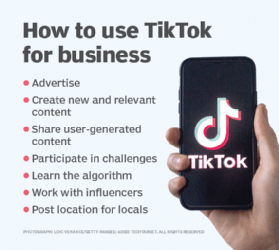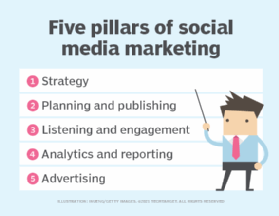TikTok
What is TikTok?
TikTok is a social media platform that allows users to create, share and discover short-form videos.
Originating in China under the name Douyin, it is the brainchild of ByteDance, a Beijing-based technology company. The platform burst onto the international stage in 2016, revolutionizing the way the world consumes and creates digital content.
TikTok's short-form videos span genres such as comedy, dance and education. Users typically create 15- to 60-second videos, often enhanced with music, filters and special effects. library of music. However, some users are producing more long-form content, with TikTok now supporting up to 60 minutes of pre-recorded material and 10 minutes of video recorded in-app.
What sets TikTok apart is its powerful algorithm, which personalizes content for each user. By analyzing viewing habits and engagement patterns, the app curates a bespoke "For You" feed, ensuring an ever-refreshing array of content that aligns with a user's preferences. This sophisticated technology encourages engagement -- scrolling, watching and, ultimately, creating.
TikTok's impact extends beyond entertainment. It has evolved into a social media platform for activism, brand marketing and talent discovery.
The history and rise of TikTok
The journey of TikTok began in September 2016 when ByteDance launched the app Douyin for the Chinese market. Within a year, Douyin had attracted 100 million users, recording more than a billion views daily. ByteDance expanded beyond China, launching TikTok internationally in September 2017.
The major turning point came in November 2017, when ByteDance acquired the social media app Musical.ly, already popular among teenagers in the U.S. and Europe. In August 2018, TikTok and Musical.ly merged, enlarging TikTok's global footprint with a diverse, international base of Gen Z users built on its existing teen demographic.
TikTok's rise to prominence is largely attributable to its unique content creation and sharing capabilities. Its user-friendly interface, combined with an extensive music library, empowered users to create engaging videos. Coupled with its powerful recommendation algorithm, TikTok quickly became a favorite among the younger demographic, who found it a refreshing and entertaining alternative to established social media apps.
Its popularity surged during the COVID-19 pandemic, as people turned to digital platforms for entertainment while staying home. The subsequent explosive rise in user engagement and content creation solidified TikTok's position as a leading social media platform.
Since 2020, TikTok has been incrementally enabling users to post longer videos. While the video time limit was originally one minute, it gradually increased to three- then five-minute videos. By 2023, the time limit was extended to 10 minutes, with 15-minute uploads available to select users for testing. In 2025, the app enabled users to upload videos up to 60 minutes long or record videos up to 10 minutes long within the app.
The move toward longer-form content gives TikTok more content monetization opportunities. Content creators and consumers on the platform expressed mixed reactions to the change. Creators said the long-form model makes it harder to earn money on the platform.
TikTok features
TikTok enables content creation that is both fun and engaging. Here are some of the most prominent TikTok features:
- Video recording. TikTok allows users to record videos within the app itself, either in a single shot or in segments, making it easy to create dynamic and multipart content.
- Video editing. The platform provides an array of video editing tools, such as trimming, cutting, merging and looping.
- Filters and effects. TikTok offers several filters and effects to add a further creative touch to user videos. These personal touches include effects such as beauty filters to enhance on-screen appearances and interactive gameplay effects.
- Sounds and voice-overs. Users can select from an extensive library of music and sound effects, or they can use the voice-over feature to narrate their videos.
- Live streaming. TikTok's live streaming feature lets users broadcast themselves in real time for immediate interaction with followers.
- Duet. This innovative feature allows users to create a side-by-side video with another user's content, facilitating collaboration and creative reinterpretation of existing content.
- Stitch. Similar to Duet, Stitch allows users to incorporate scenes from another user's video into their own, adding a unique twist to their content.
- Video reply. With the video reply feature, users can respond to comments on their videos with a video instead of a text reply.
- Hashtag challenges. TikTok's hashtag challenges encourage users to create content around a specific theme or task.
- Text-only posts. While TikTok is largely a video-centric platform, it also allows text-only posts as a new feature, enabling users to share thoughts or start discussions in a traditional social media format.
Business uses for TikTok
TikTok has emerged as a powerful marketing tool for businesses worldwide. Its algorithm and wide user base allow companies to increase their visibility and connect with potential consumers, particularly within the younger demographic. Companies have leveraged the platform's popular hashtag challenges to launch interactive campaigns, encouraging user-generated content to help boost brand engagement and awareness.

Duet and Stitch enable businesses to collaborate with influencers, tapping into their follower base and enhancing their business brand's credibility. TikTok also offers TikTok Ads, an advertising feature that allows brands to create targeted ads, based on the platform's user behavior data.
In addition, businesses have used TikTok as a storytelling medium, showcasing their company culture, values and behind-the-scenes insights through engaging video content. This helps humanize the brand and fosters a sense of connection with the audience.
Marketing videos on TikTok offer businesses a creative avenue to showcase their products and services. Businesses can use existing influencers on TikTok to enhance their reach and engagement since consumers increasingly trust recommendations from personalities they feel they know and admire. Influencers have thousands and sometimes millions of followers, and they promote a product or service in narrational videos by using the product or showing them purchase it.

Live streaming on TikTok serves as a real-time marketing tool. Businesses can use it for product releases, Q&A sessions or behind-the-scenes peeks, fostering a deeper connection with their audience. It's a unique opportunity for instant customer feedback and engagement.
TikTok is gradually becoming a hub for e-commerce, with features such as "Shop Now" links allowing businesses to seamlessly lead users from a video to a product purchase page.
Learn more about the different types of video marketing for businesses to reach consumers.
TikTok controversies
TikTok faces criticism and legal scrutiny for issues related to data privacy, user safety and content moderation, among others. These controversies underscore the complexities inherent in managing a global social media platform and highlight the need for ongoing dialogue about digital ethics and user protection.
Privacy concerns
TikTok encounters significant backlash regarding its data privacy practices, particularly the extent to which the app collects user data and how that data is handled. TikTok's data collection practices have been cited as being excessively intrusive, including the gathering of a vast array of user information such as location data, device information and personal details from social network connections.
In addition, some claim TikTok's data privacy policy leaves users uninformed about how their information is stored, used and shared. Critics argue that such practices pose significant privacy risks, especially considering TikTok's vast global user base, now at roughly 1.06 billion monthly active users.
TikTok's ownership by Chinese company ByteDance raises concerns about potential data access by the Chinese government, an obvious national security concern to several countries. While TikTok assures users that it stores data in the United States, with a backup in Singapore, the controversy continues to cast doubt on the platform's privacy practices.
In response to these concerns, TikTok has made efforts to improve its privacy practices and increase transparency, such as allowing users to view the data the app has collected about them.
Bans
TikTok's controversies extend beyond privacy concerns into the terrain of outright bans in several countries. Many nations have expressed alarm over the potential for misuse of the app by foreign governments, leading to its prohibition. For instance, India, once TikTok's largest international market and the world's largest democracy, banned the app along with several other Chinese apps in mid-2020, citing threats to its sovereignty and security.
The U.S. has also explored banning the app due to fears that the Chinese government could access user data for espionage. The first proposal to ban TikTok was submitted during President Trump's first term. TikTok struck a preliminary deal to partner with U.S. companies to alleviate these concerns, but both the ban and the deal were placed on hold under the Biden administration. In early 2024, a bill was passed that would enact the TikTok ban in January 2025.
On Jan. 18, 2025, TikTok complied with the ban and went dark in the U.S. for approximately 12 hours. However, service was then restored when newly reinstated President Trump signed an executive order to delay the ban by 75 days, to give TikTok more time to comply with the law. On April 4, 2025, Trump signed another executive order authorizing an extension of 75 days. On June 17, 2025, a third extension of 75 days was announced.
President Trump has since told the media that a group of US investors is ready to buy TikTok's U.S. business. It has also been reported that TikTok is working on a U.S.-only version of the app, internally known as M2, which would launch on Sept. 5, 2025. Together, this would make TikTok's operations compliant with U.S. law.
TikTok challenges
TikTok challenges draw concerns over safety and questions of inappropriate content. Viral trends on the platform often involve physical stunts, dances or pranks that are dangerous and can potentially lead to harm. For instance, challenges such as the "skull-breaker challenge" or the "outlet challenge" have resulted in serious injuries to participants, sparking widespread concern about the lack of adequate content moderation.
The platform also faces criticism for challenges perceived to promote negative body image, cyberbullying or inappropriate behavior, especially among younger users. Additionally, there are concerns about the use of copyrighted music in these challenges, igniting disputes over intellectual property rights. TikTok, in response, says it continues to work on improving its content moderation policies and community guidelines to create a safer and more respectful environment for its users.
User mental health worries
TikTok's continuous stream of rapid-fire, engaging content can be highly addictive, leading to excessive screen time among users, particularly younger ones. Excessive screen time has been associated with sleep deprivation, decreased productivity and increased stress and anxiety levels.
Constant exposure to potentially unrealistic portrayals of success, beauty and lifestyle can contribute to feelings of inadequacy and negative self-perception, fueling mental health issues such as anxiety and depression. Even though some users find TikTok helpful to find resources, researchers argue the algorithm exposes users to additional content that can be harmful, according to a University of Minnesota study.
Concerns also stem from the presence of inappropriate content on the platform. Despite its content moderation policies, TikTok has failed to filter content that could be distressing or triggering for young users, including violent, sexual or otherwise explicit material. This widespread availability of inappropriate content fuels criticism of the platform's efficacy in protecting its user base, particularly minors, from such harmful exposure.
Moreover, the advertising practices on TikTok raise mental health concerns. Critics argue the platform's direct advertising to minors, often for inappropriate or potentially harmful products or services, can have detrimental effects on their mental health and physical well-being. Such practices highlight the need for better monitoring and stricter regulations to protect vulnerable users from potential exploitation.